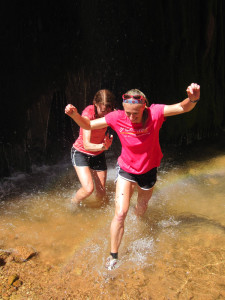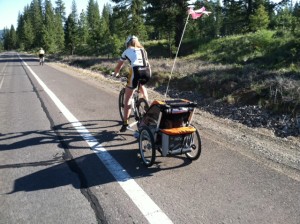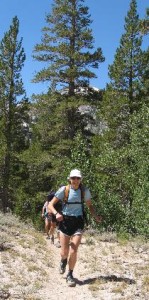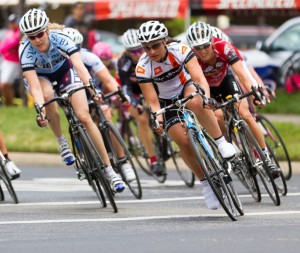Study of Two Western Staters
 In the second installment on Western States fueling strategies we interview Matt Keyes (MK) and Jamie Frink (JF), two WS veterans and race ringers, to determine if life follows fact.
In the second installment on Western States fueling strategies we interview Matt Keyes (MK) and Jamie Frink (JF), two WS veterans and race ringers, to determine if life follows fact.
Jamie’s resume includes three sub-24 hour WS finishes – 2009 8th, 2010 16th and 2011 14th.
Matt has completed five WS races, with the most recent four, sub-24 hour finishes.
Daily nutrition and race day fueling seem to be a continual subject of conversation, question and confusion. In my experience working with prominent science-based sports nutritionists on the US National Cycling team as well as my professional cycling teams, and currently Dana Liis, lead nutritionist for the Canadian national teams –it’s the same basic, albeit boring, story – the appropriate balance of carbs, proteins and fats, and good quality food choices constitute nutritional cornerstones. As with everything – we need to individualize our nutrition and fueling by taking time to fine tune these guidelines to our circumstances, response/tolerance and goals. It may not sell books, magazines or products – and may not constitute the quick fix, silver bullet some seek – but with thoughtful consistency it is effective.
Matt and Jamie’s nutritional practices seem to be text book – fueling tricks of their trail feats as follows…
Day to Day
MK: “I am diligent about topping off with carbohydrates within 30 minutes following each of my runs to replace glycogen stores and insure the muscles and liver are loaded.”
JF: “Throughout the year, I follow a balanced (no extremes) diet of carbs, proteins and fats, and try to make good food choices.”
Race Eve
MK: “I eat a giant bean and rice burrito the night before the race and chase it with some dark beer (and water). “
JF: “The night before I cook chicken, pasta, pine nuts and vegetables, while relaxing with my pre-night race ritual – a pedicure complete with paint, while watching movies.”
Race Morning
MK: “I eat yogurt, fruit, granola, a cup of coffee, some low fat milk.”
JF: “I go with coffee, a bagel and peanut butter, but race nerves make it tough to get it down.”
Once the Gun Goes Off
MK: “During the race I shoot for 200-300 calories per hour – the majority solid aid station foods – peanut butter and jelly sandwiches, potatoes, bananas and melon. Between aid stations I gel up, trying to east something every 30 minutes. I drink a mix of GU Brew electrolyte drink and water for the first half or 2/3 of the race then switch to a mix of sprite/7up and water (on the rocks). After mile 75, most of my calories come from sodas as my appetite subsides, even Gus are a challenge to choke down.”
JF: “I grab a handful of something at every aid station, even if I am not hungry I “force” feed a few bites – half a banana, peanut butter and jelly, potatoes – many times just grabbing and stashing in zip lock baggies for the trail ahead. During the first half I make a conscious effort to avoid sugar, caffeine and pain killers (boring!). But from Foresthill in – I cut loose, double fisting Gu and caffeine. I let thirst be my guide (as experts advise) for hydration.”
Jamie’s must haves on her WS movable feast, thanks to her roving crew – tuna fish sandwiches on white bread, complete with mayo, V8 juice and white powdered donuts (if not devoured by crew first).
Inquiring Minds want to know – Drop Bags?
MK: “No drop bags for me. I do ask my crew to meet me on the course at mile 30, 55, 62, 80 and maybe 93. For the first three stops I order strawberry milkshakes and walk out eating a slice of pizza.”
JF: “I use drop bags – more as a security blanket. I am lucky to have an attentive crew. But I throw in those essential powdered covered donuts, as well as a few vital articles of clothing, such as arm warmers.”
Post-Race
MK: :Usually I head for the beer tent – it’s all that really sounds good the first few hours, and a reliable medical source tells me the best way to get the body’s fluids flowing. Then several hours post-race I am ready for my Auburn stand-bys – a Taco Tree vegetarian burrito and a Depoe Bay giant blended Mocha.”
JF: “I typically have an inexplicable craving for nachos and a margarita.”
Finally, Fueling Irrelevant – Why WS?
MK: “I enjoy the training and moving outside every day. I don’t thrive on “racing” in the true sense – I am drawn to the long slow grinds in the canyons. I’ve probably run from my house to Cool and back with my favorite four legged training partner 50 times this year – I never tire of the stellar trails around Auburn.
“I also run because I can. I ran my first Western States 100 with my friend Dan Moores – three years later cancer took his life. He can’t run anymore. I can.
“I run because it keeps me sane. My wife Kim often sends me out the door to run, saying, “You should go for a run, come back when you feel better…”
“I run to show my kids (my own and kids I coach on the soccer field) that adults can still exercise and play even when they’re old.”
JF: “Initially I was drawn to WS by the sense of accomplishment. Now, it is my family that motivates me to participate. My kids are old enough to understand the accomplishment – and be proud of their mom. I also love it for the sake of it – I thrive on the training. WS and the long training days in the canyon with my training partners provide an escape from life – no phones, no computers and no work (Jamie teaches severely impaired adolescence functional skills). I own my training and racing time – no one else’s needs, decisions or actions can interfere. But ultimately it is the lasting feeling of freedom and peace that trail running provides.”





